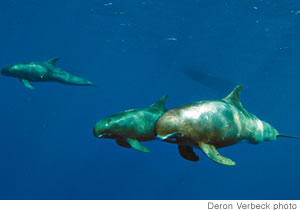Mysterious Pygmy Killer Whales

Wednesday - January 21, 2009
| Share
 Del.icio.us
Del.icio.us
|
They are one of nature’s biggest unknowns, but a new study is shedding light on the mysterious pygmy killer whale - a puzzling creature that calls Hawaii home.
Marine biologists say pygmy killer whales spotted in Hawaiian waters over the last 20-plus years don’t swim out to the open ocean. It’s the first evidence of a resident population of the species anywhere in the world.
Photographer Deron Verbeck has pictures to prove it.
“I’ve been very lucky being in the right place at the right time,” says Verbeck. “I’m always happy to share my experiences from the ocean. I hope this will help open people’s eyes to the amazing creatures we have right here in our own front yard.”
Pygmy killer whales are found in tropical and subtropical waters around the world but are not fully understood because they generally live in the open ocean - but not here. Most of Hawaii’s population is spotted off the Big Island less than four miles from shore, with the farthest sighting at just over nine miles. A few also have been seen near Oahu, Lanai and Ni’ihau.
The new study was part of a 22-year photo identification project that included photographers like Verbeck. Together they gathered more than 3,400 photos of Hawaii’s pygmy killer whales.
One of the study’s main authors is marine biologist Robin Baird from Cascadia Research Collective of Washington state. Baird believes there are probably between 50 and 200 individuals in Hawaii’s population, making them more vulnerable to fishing and Navy sonar than other whale populations.
“It’s just much more likely that human activities could impact the population, hurt the population,” says Baird.
The authors used photos to distinguish the whales by their body scars, dorsal fin shapes and other characteristics. They also found the animals are social and often stay close to others for at least 15 years.
“Some seem very curious, coming close to look at me, and I had one swim within arm’s reach, checking me out after I didn’t back down,” recalls Verbeck. “Don’t get me wrong - it charged from behind so I never saw it coming and it scared me at first, but then I was able to refocus and shoot some cool pictures.”
Verbeck witnessed how social they can be and photographed them playing, leaping, tail-slapping, bow-riding and simply resting or logging at the surface.
“Others don’t seem to care that I’m even there,” says Verbeck. “I’ve had a few logging on the surface and was able to slowly swim right up to them like I was one of the pod.”
Verbeck believes his choice to free-dive instead of using scuba gear allows him to get incredible images.
“I don’t think that a scuba diver would be able to approach them,” says Verbeck. “I think, for the most part, they stay relaxed when I’m in the water with them. I try not to crowd them and swim with them and not at them, if at all possible.”
The humble Verbeck says he is grateful marine biologists from cascadiaresearch.org invited him along for the ride. Although his photographs provide information for a ground-breaking study, he says he is the real beneficiary.
“They are the ones doing the research. I was just the lucky guy who got the photos,” he says. “When I dive, they, the pygmy killer whales, truly seem to get more curious, as if they want to know why this strange being is down here. Nice experiences.”
Nice experiences that are providing answers to questions more than two decades old.
E-mail this story | Print this page | Comments (0) | Archive | RSS Comments (0) |
Most Recent Comment(s):













